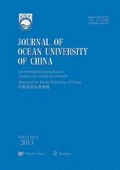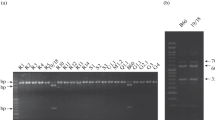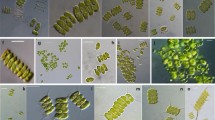Abstract
The genus Cylindrotheca consists of a small group of marine diatoms with a few species described. Eleven isolates of diatoms identified as Cylindrotheca closterium morphologically were obtained from Jiaozhou Bay with their nuclear-encoded small-subunit ribosomal RNA (SSU rDNA) and chloroplast-encoded rbcL gene sequences determined in this study. Interestingly, very high sequence divergences of SSU rDNA and rbcL gene were found among these isolates, and numerous nucleotide variation of rbcL gene caused relatively few variation of deduced amino acid sequence. Phylogenetic analyses based on SSU rDNA and rbcL gene, respectively, grouped the isolates into 6 clades. Phylogenetic tree of SSU rDNA placed all the Cylindrotheca isolates together, separating them into two lineages clearly. Lineage I was composed of the eleven C. closterium isolates obtained in this study together with another C. closterium isolate, but some clades were not well supported. Lineage II contained two C. closterium isolates and one C. fusiformis isolate. Phylogenetic analysis of rbcL gene also separated the Cylindrotheca isolates into two well-defined lineages. The eleven C. closterium isolates formed a lineage and all clades were supported strongly. Statistical comparisons of SSU rDNA indicated that the average distance within lineage I was significantly higher than that of other microalgae species (P < 0.01). These results suggested the existence of cryptic species within C. closterium.
Similar content being viewed by others
References
Anderson, R. A., and J. C. Bailey, 2002. Phylogenetic analyses of 32 strains of Vaucheria (Xanthophyceae) using the rbcL gene and ITS two flanking spacer regions. J. Phycol., 38: 583–592.
Bailey, J. C., and R. A. Anderson, 1999. Analysis of clonal cultures of the brown tide algae Aureococcus and Aureoumbra (Pelagophyceae) using 18S rRNA, rbcL, and RUBISCO spacer sequences. J. Phycol., 35: 570–574.
Behnke, A., T. Friedl, V. A. Chepurnov and D. G. Mann, 2004. Reproductive compatibility and rDNA sequence analyses in the Sellaphora papula species complexes (Bacillariophyta). J. Phycol., 40: 193–208.
Coleman, A. W., A. Suarez, and L. Goff, 1994. Molecular delineation of species and syngens in Volvocacean green algae (Chlorophyta). J. Phycol., 30: 80–90.
Daugbjerg, N., and R. A. Anderson, 1997. Phylogenetic analyses of the rbcL sequences from Haptophytes and heterokont algae suggest their chloroplasts are unrelated. Mol. Biol. Evol., 14: 1242–1251.
Denboh, T., T. Ichimura, D. Hendrayanti, and A. W. Coleman, 2003. Closterium moniliferum-ehrenbergii (Charophyceae, Chlorophyta) species complexes viewed from the 1506 group I intron and ITS2 of nuclear rDNA. J. Phycol., 39: 960–977.
Gallagher, J. C., 1982. Physiological variation and electrophoretic banding patterns of genetically different seasonal populations of Skeletonema costatum (Bacillariophyceae). J. Phycol., 18: 148–162.
Gallagher, J. C., 1980. Population genetics of Skeletonema costatum (Bacillariophyceae) in Narragansett Bay. J. Phycol., 16: 164–174.
Gilbert, J. J., and E. J. Walsh, 2005. Brachionus calyciflorus is a species complex: mating behavior and genetic differentiation among four geographically isolated strains. Hydrobiologia, 546: 257–265.
Guillard, R. R. L., 1975. Culture of phytoplankton for feeding marine invertebrates. In: Culture of Marine Invertebrate Animals. Smith, W. L. and M. H. Chaney, eds., Plenum Press, New York, 29–60.
John, U., R. A. Fensome, and L. K. Medlin, 2003. The application of a molecular clock based on molecular sequences and the fossil record to explain biogeographic distributions within the Alexandrium tamarense species complex (Dinophyceae). Mol. Biol. Evol., 20: 1015–1027.
Julius, M. L., G. F. Estabrook, M. B. Edlund, and E. F. Stoermer, 1997. Recognition of taxonomically signification clusters near the species level, using computationally intense methods, with examples from the Stephanodiscus niagarae complexes (Bacillariophyta). J. Phycol., 33: 1049–1054.
Kasai, F., and T. Ichimura, 1990. A sex determining mechanism in the Closterium ehrenbergii (Chlorophyta) species complex. J. Phycol., 26: 195–201.
Lewis, L., and V. Flechlner, 2004. Cryptic species of Scenedesmus (Chlorophyta) from desert soil communities of Western North America. J. Phycol., 40: 1127–1137.
Medlin, L. K., H. J. Elwood, S. Stickel, and M. L. Sogin, 1991. Morphological and genetic variation within the diatom Skeletonema costatum (Bacillariophyceae): evidence for a new species, Skeletonema pseudocostatum. J. Phycol., 27: 514–524.
Meyer, B., M. Wulf, and H. Hakansson, 2001. Phenotypic variation of life-cycle stages in clones of three similar Cyclotella species after induced auxospore production. Diatom Res., 16: 343–361.
Negrisolo, E., S. Maistro, M. Incarbone, I. Moro, L. D. Valle, et al., 2004. Morphological convergence characterizes the evolution of Xanthophyceae (Heterokontophyta): evidence from nuclear SSU rDNA and plastidial rbcL genes. Mol. Phylogenet. Evol., 33: 156–170.
Palumbi, S. R., 1996. What can molecular genetics contribute to marine biogeography? An urchin’s tale. J. Exp. Mar. Biol. Ecol., 203: 75–92.
Reimann, B. E. F., and J. C. Lewin, 1964. The diatom genus Cylindrotheca Rabenhorst (with a reconsideration of Nitzschia closterium). J. Roy. Microso. Soc., 83: 283–296.
Rynearson, T. A., and E. V. Armbrust, 2004. Genetic differentiation among populations of the planktonic marine diatom Ditylum brightllii (Bacillariophyceae). J. Phycol., 40: 34–43.
Sarno, D., W. H. C. F. Koostra, L. K. Medlin, I. Percopo, and A. Zingone, 2005. Diversity in the genus Skeletonema (Bacillariophyceae). II. An assessment of the taxonomy of S. costatum-like species with the description of four new species. J. Phycol., 41: 151–176.
Tomas, C. R., 1997. Identifying Marine Phytoplankton. Academic press, San Diego, 858 pp.
Vardy, S., and P. Uwins, 2002. Fourier transform infrared microspectroscopy as a tool to differentiate Nitzschia closterium and Nitzschia longissima. Appl. Spectro., 56: 1545–1548.
Wood, A. M., R. Lande, and G. A. Fryxell, 1987. Quantitative genetic analysis of morphological variation in Antarctic diatom grown at two light intensities. J. Phycol., 23: 42–54.
Author information
Authors and Affiliations
Corresponding author
Rights and permissions
About this article
Cite this article
Li, H., Yang, G., Sun, Y. et al. Cylindrotheca closterium is a species complex as was evidenced by the variations of rbcL gene and SSU rDNA. J Ocean Univ. China 6, 167–174 (2007). https://doi.org/10.1007/s11802-007-0167-6
Received:
Accepted:
Issue Date:
DOI: https://doi.org/10.1007/s11802-007-0167-6




